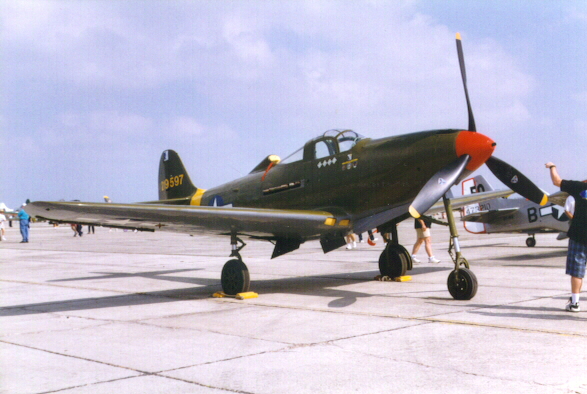![]()
This relatively small "Air corps" fighter was first designed in 1937 as an INTERCEPTOR and was powered by a V-12 liquid cooled, supercharged engine of 1150 hp. It was designed around a 37 MM cannon which fired through the spinner. The engine was mounted behind the pilot seat. The first flight was in April of 1938. It had an excellent rate of climb, reaching 20.000 feet with a speed of 390 MPH. Speeds of 600 MPH were reached in a terminal velocity dive.
The Army decided it had no use for an interceptor aircraft of this type and had the supercharged engine replaced by a less powerful one. The "Peter three nine" was re-designated as a medium altitude fighter. As the highly successfull P-38 was also being designed at this time, the "Turbo" engines were needed by it.
After many changes and the addition of armor plating, more guns and advanced communications gear the little P-39 suffered in performance.
The "YP" model order of 13 was put in the test program in late 1940. The first full production models (C) went into service in 1941. Production continued, with numerous changes until 1944.
The plane below is an example of the "Q" model P-39 and is owned by the CONFEDERATE AIR FORCE, of which I am a member.

Of the almost 10,000 'Cobras built this is the only one still flying. There are several on static display at various museums around the country.
![]()
Here is the same "ancient" airplane with an even more "ancient" former P-39 pilot. They appear to be holding each other up.

This aircraft was chosen to be enshrined here not because it was a "great" airplane, but because I have almost 400 of my 1200 plus military hours in this type of fighter. We grew to love each other despite its limitations.
The plane pictured has all the guns removed, the armour protection taken off and light weight communications equipment installed.
This makes it much lighter and faster than when I flew them.
Shortly after WWII a couple of Bell factory pilots stripped two P-39Qs and took them racing. One crashed shortly after qualifying. The remaining plane won the Thompson Trophy at the Cleveland Air Races in 1946. It went on to race in '47 and '48. In the last race the top speed attained was 373 MPH (around pylons). Not too shabby.
In 1969 that plane crashed while attempting to break the speed record for propeller-driven aircraft.
![]()